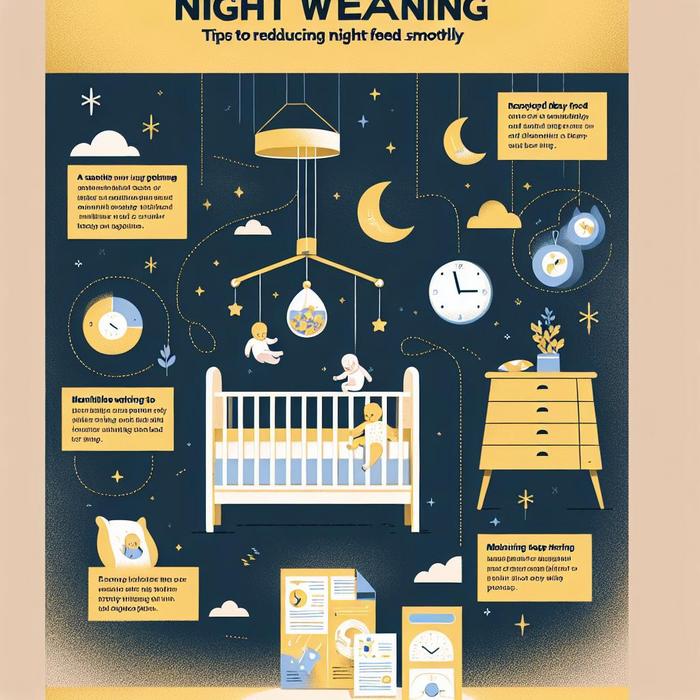Tackling the Challenge of Night Weaning
Night weaning is one of the most challenging aspects of early parenting. The process involves gradually decreasing nighttime feeds to help your baby sleep longer periods. Contrary to what many people think, night weaning doesn’t mean completely stopping breastfeeding or bottle-feeding; rather, it’s about reducing feeds at night and balancing them during the day. Here, we’ll share some tried and true night weaning tips to make the transition easier for you and your little one.
Understanding Your Baby’s Sleep Pattern
Before diving into the world of reducing night feeds, it’s essential to understand your baby’s sleep pattern. Not every baby follows the same sleep schedule, so be patient with yourself and your little one. The experts at “Talk in Sleep” note that observing your baby’s sleeping habits can give you a clear idea of when to start night weaning. It’s important to remember that sleep is as crucial for babies as food. Both these elements work hand in hand to ensure your baby’s healthy growth and development.
Gradual Reduction of Night Feeds
When it comes to reducing night feeds, patience and gradual changes are key. A sudden drop in feeding can lead to distress for both the baby and the parents. According to What to Expect, parents should start by slowly reducing the quantity of milk during the night feeds or shortening nursing times. This will gradually shift more feeding to the daytime, helping your baby adjust to the new routine while ensuring they still get the necessary nutrition. It’s also crucial to maintain day feeding to compensate for the reduced night feeds.
Establishing a Comfortable Sleeping Environment
Creating a peaceful and comfortable sleeping environment can significantly support your night weaning efforts. Here are some strategies to consider:
- Ensure the room is at an optimal temperature.
- Use soft, dim lights during the night feeds to create a sense of tranquility.
- Consider a white noise machine or a soft lullaby to help your baby fall asleep quickly after the feed.
- Use comfortable and soft bedding materials.
Remember, every little detail counts in establishing a soothing sleep routine for your baby.
Soothing Techniques To Ease The Transition
Weaning is a challenging process for babies. They may experience restlessness or anxiety during this change. Therefore, incorporating soothing techniques can help ease this transition.
One method is to introduce a comfort object such as a soft toy or a blanket that your baby can associate with comfort and sleep. Another technique is gentle rocking or cuddling before bedtime to help your baby feel safe and secure. You can also follow a simplified version of a family bedtime routine that includes activities like reading a bedtime story to your baby. This familiar routine can be comforting and signal to your baby that it’s time to sleep.
The idea is to create a secure, comforting environment where your baby feels loved and calm, easing the transition into reduced night feeding.
Maintaining Consistent Sleep Routines
Maintaining sleep routines is essential during the night weaning process. A consistent bedtime routine can give your baby the predictability needed to ease their anxiety about reduced night feeds. Whether it’s a warm bath, bedtime story, or a soothing lullaby, it’s important to remain consistent with these routines. Remember, it’s not only about reducing night feeds but also about helping your baby maintain good sleep habits.
If your baby wakes up at night and demands to feed, try soothing them back to sleep using the comfort object or the soothing techniques mentioned earlier. If your baby still seems hungry, try to keep the feed short and quiet.
Consistency and patience are key during this transition period. While it can be challenging, remember that your efforts are laying the groundwork for healthy sleep habits in the future.
Ready to take on night weaning? Remember, every baby is different, and what works for one may not work for another. It’s about trying different strategies and seeing what works best for your little one. Good luck on your night weaning journey!
Useful Night Weaning Resources
Luckily, parents and caregivers aren’t alone in the night weaning process. There are a plethora of resources that provide expert advice, including research-based tips by renowned lactation consultants and pediatricians. Some standout resources include the following.
- Arlie Hastings, a lactation consultant, offers gentle strategies to stop breastfeeding at night.
- The Bellefit blog shares insights for a smooth transition to less frequent night feeds.
- The creators of the Magic Sleepsuit offer advice on transitioning toddlers away from a bedtime bottle.
- Dr. Sears, a pediatrician renowned for his parenting advice, offers suggestions on how to gently end night feedings.
Partner Involvement in Night Weaning
Another strategy that can ease the night weaning process is involving your partner or other caregivers. Partner involvement can provide extra comfort and help the baby adjust more quickly to the change. The partner can assist with the bedtime routine, offer the bottles or pacifiers, or help soothe the baby back to sleep. Shared responsibility ensures that both parents are on board with the new routine, creating consistency for the baby.
Professional Support for Night Weaning
It’s important to remember that if night weaning becomes too challenging or if your baby shows any signs of distress or poor health, consultation with a healthcare provider is recommended. Pediatricians, lactation consultants or experienced child sleep consultants can provide tailored advice suited to your baby’s specific needs. They also can help address any potential underlying issues affecting your baby’s sleep.
Creating a Positive Outlook About Night Weaning
Lastly, having a positive outlook about the night weaning process can make a significant difference. Remember, night weaning is not about denying your baby nutrition or comfort but more about teaching them a new skill. Celebrate each success and be patient with each hiccup. Some babies take a while to adjust to the new routine, but over time they will begin associating sleep with comfort instead of just associating it with feeds.







